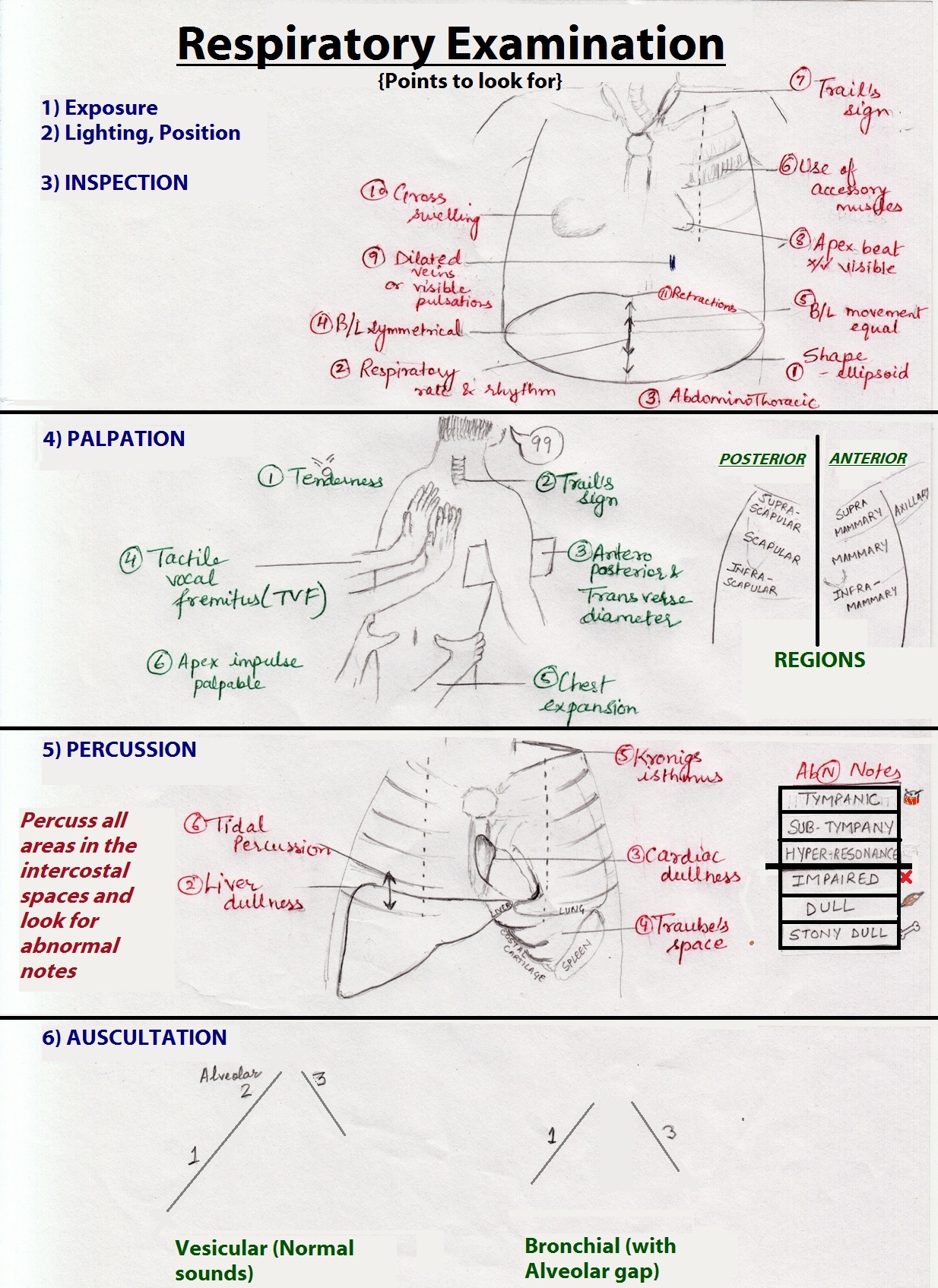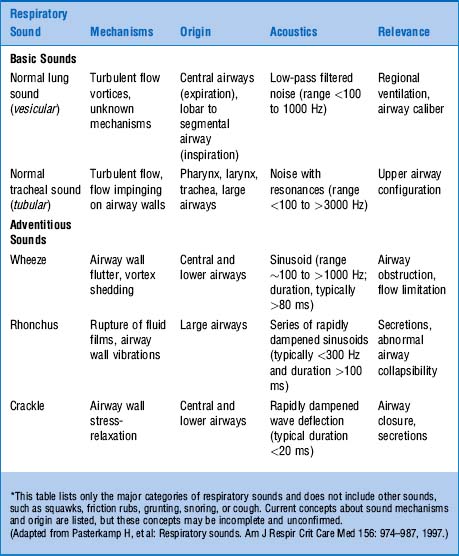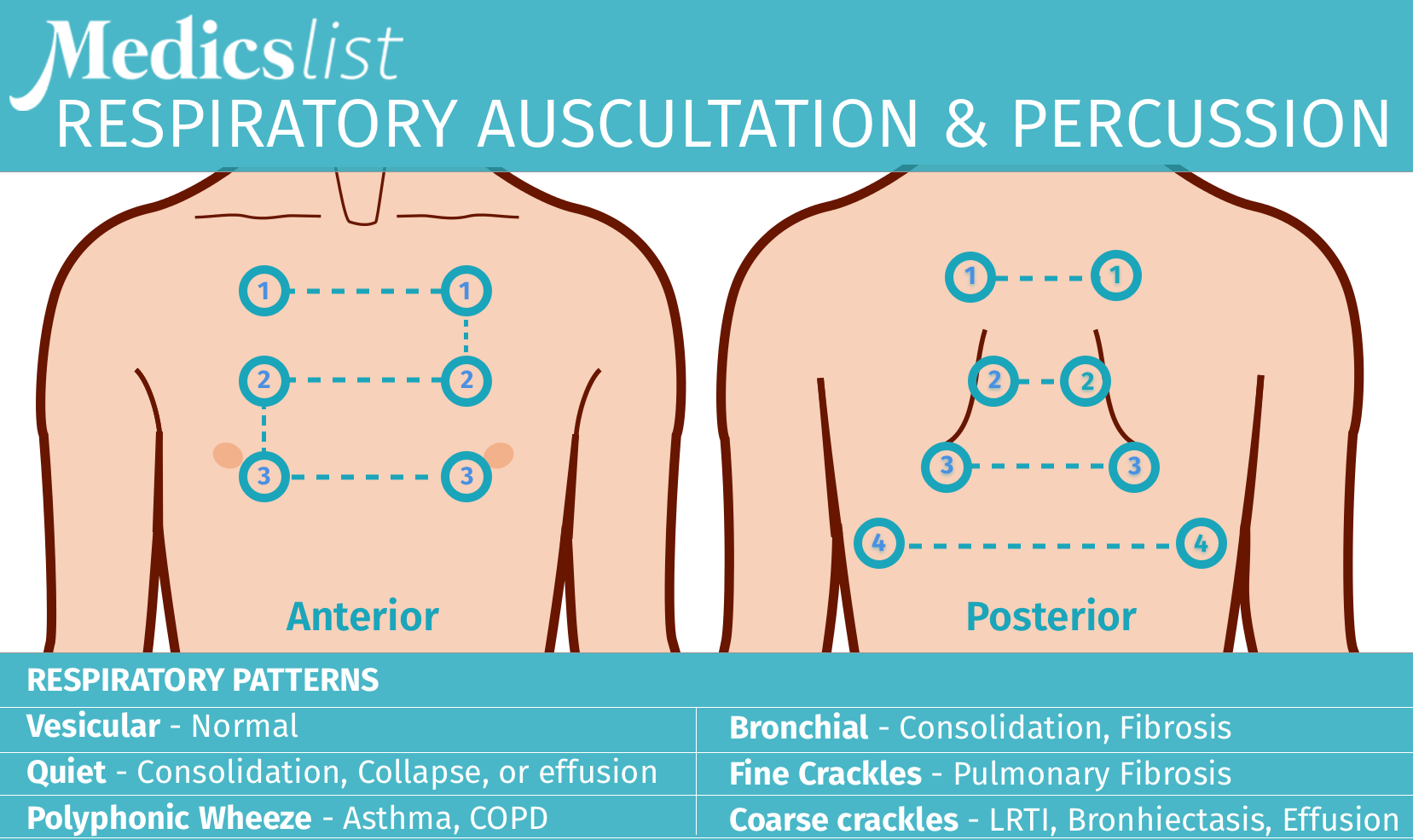Crackles also known as rales are short explosive lung sounds that are commonly heard in the small or middle airways of the lungs. How to auscultate lung sounds the basics of lung auscultation.
 Respiratory Examination Wikipedia
Respiratory Examination Wikipedia
When crackles are heard during auscultation it can be associated with fluid or secretions in the lungs.

Auscultation of lungs sounds. It is a fundamental component of physical examination that can assist in the diagnosis of respiratory issues and identification of abnormal or adventitious noises. It is a technique used to examine the respiratory system breath sounds cardiovascular system heart sounds and vascular bruits and gastrointestinal system bowel sounds. Abnormal lung sounds such as stridor rhonchi wheezes and rales as well as characteristics such as pitch loudness and quality can give important clues as to the cause of respiratory symptoms.
Lung sounds also called breath sounds can be auscultated across the anterior and posterior chest walls with a stethoscope. All these conditions prevent airflow reaching parts of the lung due to a pathological change in the function of the lung. Crackles can occur on both inspiration and expiration but are more common during the inspiratory phase.
This describes a lack of audible breath sounds on auscultation. Chest auscultation involves using a stethoscope to listen to a patient s respiratory system and interpreting the lungs sounds heard. It s a term meaning to listen to sounds inside of a person.
Breath sounds may be heard with a stethoscope during inspiration and expiration in a technique called auscultation. Adventitious lung sounds are referenced as crackles rales wheezes rhonchi stridor and pleural rubs as well as voiced sounds that include egophony bronchophony and whispered pectoriloquy. If your doctor thinks you might have an issue with your lungs the type and location of certain breathing sounds can help them figure out what might be behind it.
The modern method is to use a stethoscope. Auscultation is the act of listening to sounds made by internal organs and vessels of the human body. It could be caused by lung disorders that inhibit the transmission of sounds for example a pneumothorax pleural effusion or areas of lung consolidation.
We use it when referring to listening to lung sounds. The traditional method was to place an ear over the patient s chest. Listen to both the anterior and posterior sides of the chest start at the top and work your way to the bottom of the chest while comparing sides watch the video for the technique.
This is usually done with a device called a stethoscope.
 Lung Auscultation Basicmedical Key
Lung Auscultation Basicmedical Key
 Lung Sounds Over 50 Lessons Reference Guides And Quiz
Lung Sounds Over 50 Lessons Reference Guides And Quiz
 Not Found Nursing School Survival Nursing School Studying Nursing Study
Not Found Nursing School Survival Nursing School Studying Nursing Study
 How To Perform Chest Auscultation And Interpret The Findings Nursing Times
How To Perform Chest Auscultation And Interpret The Findings Nursing Times
 Lung Auscultation Physical Therapy Reviewer
Lung Auscultation Physical Therapy Reviewer
 Where To Listen To Lung Sounds The Complete Guide To Respiratory Auscultation Examination
Where To Listen To Lung Sounds The Complete Guide To Respiratory Auscultation Examination
 Auscultation Of Lungs Sounds Nursing School Survival Lung Sounds Nursing Students
Auscultation Of Lungs Sounds Nursing School Survival Lung Sounds Nursing Students
 Influence Of Observer Preferences And Auscultatory Skill On The Choice Of Terms To Describe Lung Sounds A Survey Of Staff Physicians Residents And Medical Students Bmj Open Respiratory Research
Influence Of Observer Preferences And Auscultatory Skill On The Choice Of Terms To Describe Lung Sounds A Survey Of Staff Physicians Residents And Medical Students Bmj Open Respiratory Research
 How To Perform Chest Auscultation And Interpret The Findings Nursing Times
How To Perform Chest Auscultation And Interpret The Findings Nursing Times
 Fundamentals Of Lung Auscultation Nejm
Fundamentals Of Lung Auscultation Nejm
Tom Prophet Hsiung Fundamentals Of Lung Auscultation
 Characteristics Of Breath Sounds Vesicular Broncho Vesicular Bronchial Tracheal Auscultation Breath Sounds Physicalexam
Characteristics Of Breath Sounds Vesicular Broncho Vesicular Bronchial Tracheal Auscultation Breath Sounds Physicalexam
